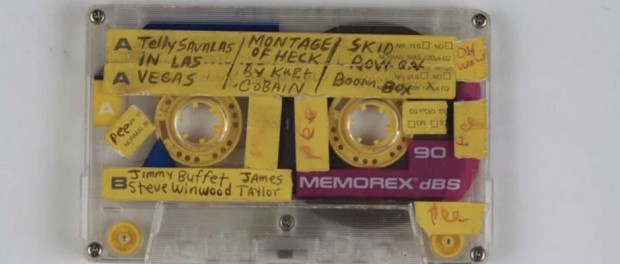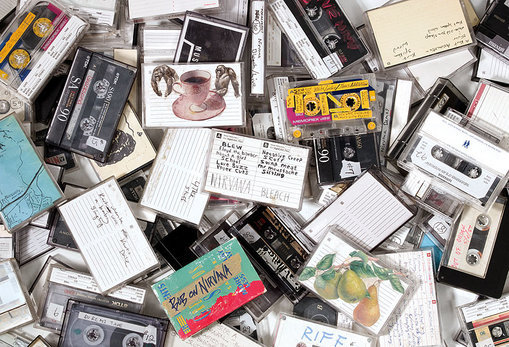Tape Me: Re-Considering Kurt Cobain’s Montage of Heck
Saving Kurt Cobain's scraps from the sneers of the critics.

Much commentary so far on the newly released Kurt Cobain – Montage of Heck: the Home Recordings soundtrack has been an example of how, over time, idolized figures in popular culture have their rough edges sanded away, their awkwardness removed, their sense of risk and threat neutered. I’m reminded of Ronald Reagan praising Martin Luther King Jr. in the mid-80s with terms of such emasculated emptiness that it erased the history of MLK’s confrontation with the American mainstream; his campaigns to secure recognition of the economic conditions of the African-American populace; his opposition to Vietnam; how much he scared and infuriated much of white America.
Among some critics, and some audiences, the same rose-tinting process has happened to Kurt Cobain and Nirvana.
OH THE GUILT
In the alternative universe posited, Kurt Cobain was a guy who churned out catchy three minute verse-chorus-verse pop songs with sweet melodies. This one-dimensional vision takes MTV Unplugged in New York as the true face of Nirvana, with the relative polish of Nevermind as the only other touchstone of the Nirvana sound. In reality, Unplugged was a dipped toe on a mainstream TV channel while Nirvana were a band who tagged ragged noise-jams onto both their major label albums – ‘Endless Nameless’ and ‘Gallons of Rubbing Alcohol Flow Through the Strip’ respectively – and who openly denigrated the high production values and niceties of Nevermind then reacted by headed back to an underground producer with a caustic reputation, Steve Albini, to add scar tissue to In Utero. This Nirvana screamed, pounded and roared across their catalogue.
The increasingly prevalent, uncontroversial vision of Cobain has led to much discomfort when brought face-to-face with the trashy home noise experiments of MOH. In truth, those experiments give a genuine and honest picture of Cobain’s multi-faceted – and not always palatable – creativity. It’s a failure of memory on the part of people who have willfully forgotten or ignored the Cobain who recorded a masturbatory noise solo to accompany a William S. Burroughs reading; who lent vocals and noise effects to the brutality of Earth; who patiently stitched together a 30+ minute noise collage from TV detritus, his record collection and noises of his own creation for the project that gave this album its name. The soundtrack deserves credit for refusing to continue the air-brushing of Cobain’s artistic urges – the gross desire to make a pretty corpse of him – instead adopting an expansive ‘warts and all’ openness.
Cobain, in the Michael Azerrad biography Come as You Are, describes one possible future as “I really like the idea of low-fi recordings and to throw out something that hasn’t been worked on as feverishly as I would a Nirvana project.” In this light, the soundtrack, in its conceptualization, fits entirely with Cobain’s oddball instincts, with his punk ethos, with his underground spirit. He went on suggest he might start a label called Exploitation Records: “I’m just going to record street bums and retarded people and people with deformities and mental deficiencies…” To claim the soundtrack is unrepresentative of Cobain is a failure to recognize who he really was. The expansion and warping of his on-vinyl legacy is valid while the desire to swaddle an unblemished image – one that only the most saccharine and safe mainstream tastes could find appealing – is the approach worthy of disgust.
CURMUDGEON
The reasons for rejecting the soundtrack have taken a range of wrong-headed lines. One supposes that “Kurt Cobain would never have allowed these recordings to emerge.” The truth is there’s no way of knowing what a 48 year old Cobain would have done with his own archives. Cobain had already shown a willingness to cannibalize his leftovers for 1992’s Incesticide compilation which was directly motivated by a desire to grab a few fistfuls of Christmas dollars at the peak of Nirvana’s fame. Recognizing this takes nothing away from the fact that he selected what he felt were the best songs available – nothing unfinished, nothing instrumental, nothing home-recorded – and created a superb overview of the band’s edgier studio work. On the other hand, holding up a false image of Cobain as a pure, uncompromised idol would be a sullying of his complex humanity.
There’s a tragi-comical historical amnesia which overlooks the simple fact that Cobain was famous for less than 2 ½ years of the 12 years he spent recording music between 1982 and 1994. He lived out most of his life in a swirl of DIY-ethics, punk values and hand-to-mouth living. Cobain’s music is falsely seen in light of other mainstream releases when, for most of his life, what he worked toward was the acid-fried hallucinations of the Butthole Surfers, the whimsy of the Vaselines, the naked aggression of early Swans or Black Flag. It’s a sign of how far distant the memory of punk is that a record like Montage Of Heck can be denigrated for not living up to the polished plastic surgery that makes up the core of modern pop music, when the soundtrack is entirely true to the spirit of the alternative scene which Cobain never truly wished to leave.
Similarly, when attempting to showcase the solo work of Cobain, the documentary’s director (and soundtrack overseer), Brett Morgen, simply didn’t have the luxury in 2015 that Cobain had when ruling out non-studio leftovers in 1992. Cobain was not a Jimi Hendrix, nor a Tupac Shakur – each of whom benefitted from near unlimited studio time. Nirvana spent around 80 days in studio between their first session in January 1988 and their last in January 1994 – they were too poor to record endlessly in professional surroundings. The soundtrack is an accurate culling of what Cobain, the individual not the band leader, created with the resources available to him. This is a poverty-stricken dropout in a decaying mining/logging region endeavoring to create homemade self-expression in spite of obstacles and pressures; that’s a story that, to me, feels a lot more heroic and desirable than one about a rich rock star making another digitally polished disc.
RADIO-FRIENDLY UNIT SHIFTER
Unfortunately, the backlash is predictable and comprehensible with all parties carrying some responsibility. The publicity campaign related to the multi-platform Montage of Heck release began way back in the autumn of 2014. The sheer quantity of praise, of coverage, of news updates has now stretched over 12 months exhausting fans and media alike. The excitement and anticipation that was ubiquitous in early 2015 has given way to boredom, contrariness, the need for a new (negative) angle to prolong coverage, a sense of “enough already!” The widely divergent separation of components – cinema release, TV showing, DVD, book, soundtrack – was unwise because there’s no way to sustain the initial good will over such a prolonged period of time. A soundtrack release in April/May 2015 would have found a far more sympathetic hearing.
Worse, even Morgen, who put together the track-listing, disowns two of the retail versions and refers only to the 31 track deluxe as “the album.” A Super-Deluxe box has pleased no one given it consists of two formats of the same film (DVD and Blu-ray), two formats of the same album (deluxe CD and cassette but no vinyl), then multiple pieces of ephemeral nonsense. Such waste is simply depressing and it extends to the purposeless 13 track ‘standard’ CD. Such a curtailed release may have been (just about) justified if it had eliminated the experimental pieces and corralled the full songs into a single disc for those allergic to the call of the weird. Instead it haphazardly culls some songs, some experiments, leaving 13 tracks with no aesthetic unity and no logical purpose other than to leave the unfortunate impression that a lack of care and a desire to milk fans lie behind the choices.
The multi-channel experience woven around the film was very clever: the film made for an immersive cinema experience and similarly intriguing home viewing. The book allowed the interviewees to expand on their experiences in what is essentially a discussion among family; the music release is a vital core to it all. On the other hand, by adding so many bells and whistles to what is a relatively low-key compilation of sketches, there’s no way the end release could fail to underwhelm. The layering of deluxe, super-deluxe and multi-formats – a stack usually reserved for critically and historically significant albums – means the soundtrack release is being viewed as if it were meant to be a ‘great lost Cobain album’ and compared in the company of the year’s biggest releases. It’s a burden that a soundtrack release, let alone this specific material, isn’t meant to carry.
SELF-APPOINTED JUDGES JUDGE
The media is therefore flooded with criticism of the release. Yet the majority of newspaper culture sections, music magazines/websites are thoroughly compromised. Their core claim is that if it wasn’t for Cobain’s fame, then this compilation of doodles would be unworthy of attention. It’s the music press though who are directly responsible for giving it so much space. There’s a barely examined double-standard, in demanding that the Estate of Kurt Cobain and his record label leave him alone, coming from media sources who have spent a year garnishing their readership stats on the back of Cobain’s enduring popularity. One snarky mindless comment ran “Can’t he just stay dead?” – to which the answer is not so long as music news sources want to use him to gather re-tweets, clicks, likes, reads and re-posts in order to please advertisers and enhance traffic.
The counter-argument has been that there’s an obligation to cover ‘major events’ in music – but it’s a fig-leaf. No one is demanding the coverage. In the case of lesser artists, reviewers regularly exercise their right to remain silent, to preserve their integrity. When it comes to certain marquee names, however, there’s a self-imposed obligation to say something – to feed from the same well of public interest that the reviewers then disparage as prurient and voyeuristic. The irony of click-bait articles arguing the wrongs of posthumous releases seems lost on the commentators.
The fallback position has been to pretend to approach the release just as music – then to criticize it for musical failings and for the inability to approach it without wider context. There’s a pile-up of logical fallacies at work. This isn’t ‘just music’ – it’s a historical document and decontextualizing the release is simply foolhardy. Likewise, the recordings need to be positioned historically as part of the DIY and Outsider Art traditions, not as part of pop; these pieces are being compared against the wrong musical backdrop.
WHAT ELSE SHOULD I BE?
At the 1992 MTV Video Music Awards Cobain thanked “the true fans,” smirking at the irony of a room full of people responding with a cheer – when they were precisely the scenesters, casual fans and poseurs he despised. In 1990 he protested that “This is the first time in rock ‘n’ roll history where parents and children listen to the same stuff. Y’know? This is the first time it’s happened in thirty years. It’s amazing. That’s not rock ‘n’ roll! It’s not supposed to be…” He detested the generic mass audience – precisely the people Montage of Heck isn’t intended for but who seem to own the commentary upon it – for loving ‘Smells Like Teen Spirit’ but finding ‘Heart Shaped Box’ too edgy. When he told fans who didn’t share his ethos to “leave us the fuck alone!” in 1992 he was speaking to those who had devoured the polish of Nevermind yet never cared a jot for the scrappy lo-fi explorations of the underground.
Now here we are, with an archive release thoroughly in line with his whimsical urges; bringing his entirely suppressed experimental side into the light largely for the first time; in line with his noisier instincts. Similarly, Montage of Heck shows an honesty in combining not just Cobain’s pop gifts but his erraticism too. It fights against the gentrification of someone who kicked against comfort, conformity and assimilation into the perma-tanned white teeth world of superstardom – we should be glad that Cobain’s work can still cause a fight just like it once did. And it’s amazing that, in an era where ever less commercial and artistic risk can be taken on a major label, there’s a release that is quite this anti-commercial and extreme. It’ll drive away the hipsters and that, surely, would make Cobain smile.
The truth is that archive releases from posthumous artists will always be uncomfortable given the absence of authorial voice, the unavoidable association with death. The argument that means leftovers should only be accessible to record industry insiders, or within carefully controlled academic spaces, speaks volumes about the elitism of some critics. The suggestion is that music fans don’t have the intelligence to view such material in a enlightened context and that they need to be protected from themselves. In this case, there are few fans awaiting Cobain’s White Album, or who are unaware that what they’re about to hear is a man, not a superman. That desire to re-connect with an individual is an honorable emotion. Likewise, what we hear – at long last – is not the doom-laden portentous Cobain, but a figure just playing loosely for the hell of it. A chance, for once, to have fun with the legend.
The Montage of Heck release, contrary to the verbiage lavished upon it, is a low-stakes situation. The release of this music doesn’t tarnish a legacy – it enhances and humanizes a figure who was in danger of floating off into untouchability. There’s no harm caused to fans or to Cobain’s long scattered ashes by this release – those who wish to will hear it at barely more than the cost of a couple of coffees, or illegally. The cash accumulated by the record label will cover production costs, provide seed money to be invested in other artists, support recording facilities and music venues, help support the living costs of families for whom the main breadwinner works in the music industry. A small quantity will go to Cobain’s family, just as the sell-off of parental goods and inherited objects would go to you. This may not add up to make Montage of Heck an absolute good, but its compromised reality sure ain’t evil.




